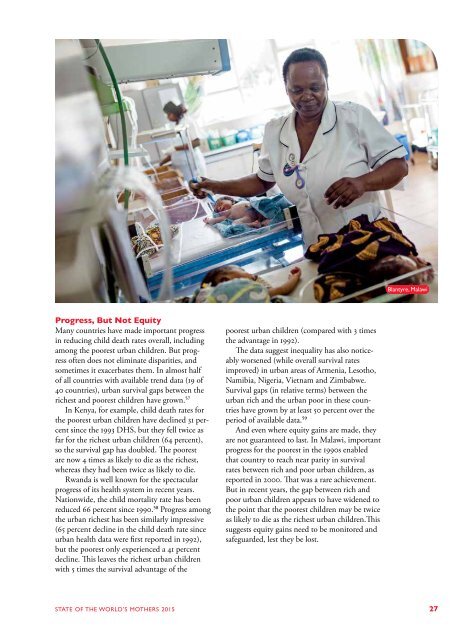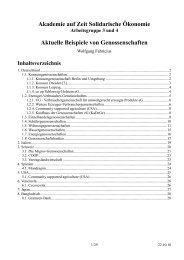sowm_2015__int__africa_full_report_low_res
sowm_2015__int__africa_full_report_low_res
sowm_2015__int__africa_full_report_low_res
Create successful ePaper yourself
Turn your PDF publications into a flip-book with our unique Google optimized e-Paper software.
Blantyre, Malawi<br />
Prog<strong>res</strong>s, But Not Equity<br />
Many countries have made important prog<strong>res</strong>s<br />
in reducing child death rates overall, including<br />
among the poo<strong>res</strong>t urban children. But prog<strong>res</strong>s<br />
often does not eliminate disparities, and<br />
sometimes it exacerbates them. In almost half<br />
of all countries with available trend data (19 of<br />
40 countries), urban survival gaps between the<br />
richest and poo<strong>res</strong>t children have grown. 57<br />
In Kenya, for example, child death rates for<br />
the poo<strong>res</strong>t urban children have declined 31 percent<br />
since the 1993 DHS, but they fell twice as<br />
far for the richest urban children (64 percent),<br />
so the survival gap has doubled. The poo<strong>res</strong>t<br />
are now 4 times as likely to die as the richest,<br />
whereas they had been twice as likely to die.<br />
Rwanda is well known for the spectacular<br />
prog<strong>res</strong>s of its health system in recent years.<br />
Nationwide, the child mortality rate has been<br />
reduced 66 percent since 1990. 58 Prog<strong>res</strong>s among<br />
the urban richest has been similarly imp<strong>res</strong>sive<br />
(65 percent decline in the child death rate since<br />
urban health data were first <strong>report</strong>ed in 1992),<br />
but the poo<strong>res</strong>t only experienced a 41 percent<br />
decline. This leaves the richest urban children<br />
with 5 times the survival advantage of the<br />
poo<strong>res</strong>t urban children (compared with 3 times<br />
the advantage in 1992).<br />
The data suggest inequality has also noticeably<br />
worsened (while overall survival rates<br />
improved) in urban areas of Armenia, Lesotho,<br />
Namibia, Nigeria, Vietnam and Zimbabwe.<br />
Survival gaps (in relative terms) between the<br />
urban rich and the urban poor in these countries<br />
have grown by at least 50 percent over the<br />
period of available data. 59<br />
And even where equity gains are made, they<br />
are not guaranteed to last. In Malawi, important<br />
prog<strong>res</strong>s for the poo<strong>res</strong>t in the 1990s enabled<br />
that country to reach near parity in survival<br />
rates between rich and poor urban children, as<br />
<strong>report</strong>ed in 2000. That was a rare achievement.<br />
But in recent years, the gap between rich and<br />
poor urban children appears to have widened to<br />
the po<strong>int</strong> that the poo<strong>res</strong>t children may be twice<br />
as likely to die as the richest urban children.This<br />
suggests equity gains need to be monitored and<br />
safeguarded, lest they be lost.<br />
STATE OF THE WORLD’S MOTHERS <strong>2015</strong> 27




